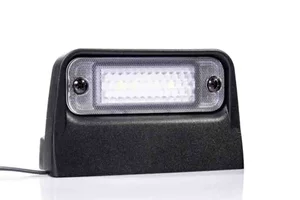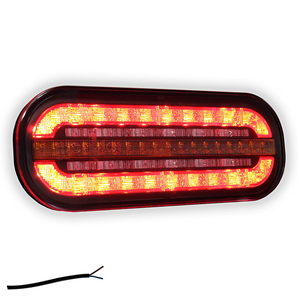In this comprehensive guide, we explore the rules and regulations for trailer lighting. This ensures that your trailer complies with European legislation.
In this blog you will learn:
- Which lighting is mandatory on a trailer
- Where the lighting should be placed (installation requirements)
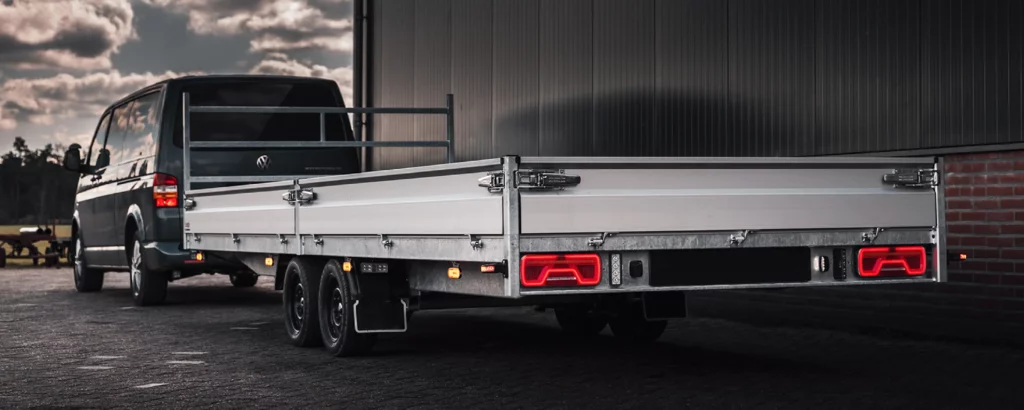
What Lighting Does My Trailer Need?
The mandatory lighting on a trailer consists of:
- At the front: 2 white reflectors.
- On the rear side:
- 2 red taillights
- 2 brake lights
- 2 indicators, amber
- License plate light, white. At least one lamp that illuminates the entire plate.
- 2 red reflectors in a triangular shape
Height: Minimum 0.35 meters and maximum 1.50 meters above the road surface
- On the sides: 1 amber reflector, in the middle third of the trailer.
These are the basic requirements for a trailer with a width of less than 160 cm and up to 6 meters in length.
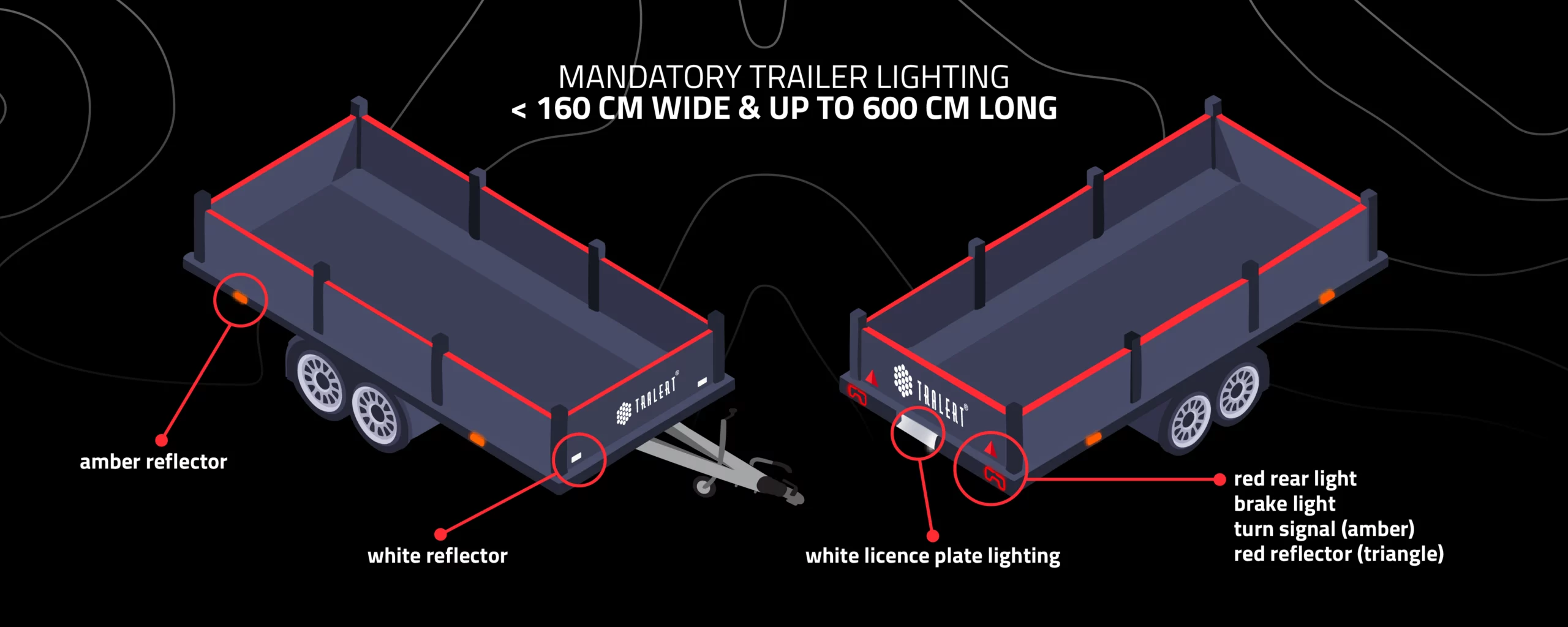
Requirements for trailers between 160 cm and 210 cm wide
Front side:
- Reflektoren: Zwei weiße Retroreflektoren
Platzierung: Symmetrisch auf beiden Seiten der Mitte.
Höhe: Mindestens 0,25 Meter und maximal 0,90 Meter über der Fahrbahn.
- City lights: Two white lamps (mandatory if the trailer was put into service after June 30, 1967).
Placement: Symmetrically on both sides of the center.
Height: No specific height requirement, integrated into the design.
Rear side:
- Brake lights: Two red lamps.
Placement: Symmetrically on both sides of the center.
Height: Minimum 0.35 meters and maximum 1.50 meters above the road surface.
- Brake lights: Two red lamps.
Placement: Symmetrically on both sides of the center.
Height: Minimum 0.35 meters and maximum 1.50 meters above the road surface.
- Direction indicators: Two amber lamps.
Placement: Symmetrically on both sides of the center.
Engels: Height: Minimum 0.35 meters and maximum 2.10 meters above the road surface.
- Rear license plate lighting: White, at least one lamp that illuminates the entire license plate.
- Rear fog light: One red lamp
Placement: In the center or to the left of the center.
Height: Minimum 0.25 meters and maximum 1.20 meters above the road surface.
- Reflectors: Two red retroreflectors in a triangular shape.
Placement: Symmetrically on both sides of the center.
Height: Minimum 0.35 meters and maximum 1.50 meters above the road surface.
Side:
- At least 1 amber reflector per side, preferably in the middle section of the trailer. Height: Between 0.25 meters and 1.50 meters above the road surface. If structurally not otherwise possible: Maximum 2.10 meters above the road surface.
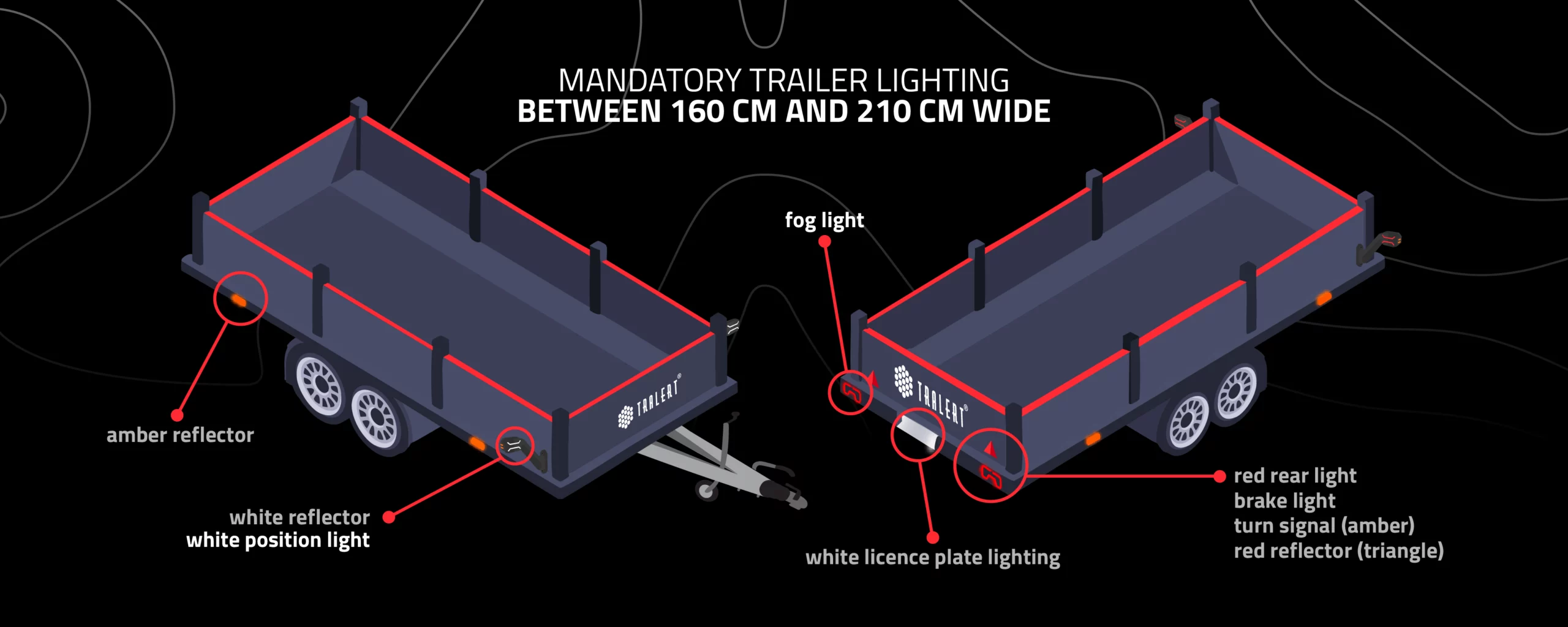
Additional rules for trailers wider than 210 cm
For enclosed trailers with a height of more than 1.80 meters, the side marker lights must be placed both at the bottom (between 0.25 meters and 1.50 meters) and as high as possible near the upper edge. This ensures that the trailer's contours, both top and bottom, are clearly visible to other road users. If technically not otherwise possible, the upper marker lights may be mounted at a height of up to 2.10 meters.
- Front marker lights (white):
These must be placed at the outermost width points of the trailer, as high as possible. For closed trailers, a minimum height of 1.8 meters above the road surface is required. In practice, these lights are often integrated into width lamps.
- Rear marker lights (red):
These are also placed at the outermost width points. For closed trailers, the same height restrictions apply as for the front, while for open trailers, the lights may be mounted between 0.25 meters and 1.50 meters above the road surface. Here too, width poles are often used as they can combine both front and rear marker lights into one construction.
Placement of marker lights
- For closed trailers, the marker lights must be placed as high as possible, with a minimum height of 1.8 meters above the road surface.
- For open trailers, where such a height is not feasible, the marker lights may be placed at a height between 0.25 meters and 1.50 meters above the road surface.
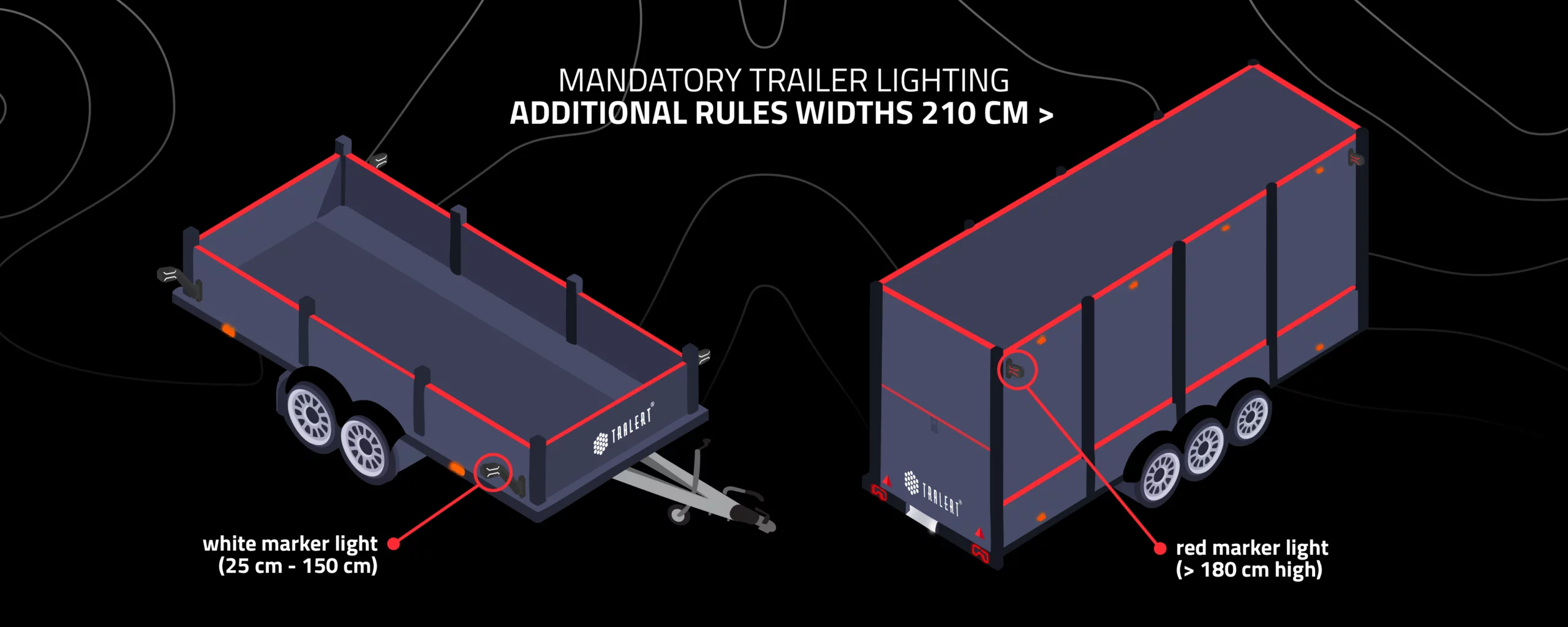
Requirements for the sides at specific lengths
Longer trailers have additional lighting requirements.
Trailer between 160 and 210 cm wide
Each side must be equipped with at least one amber reflector. This reflector should preferably be placed in the middle section of the trailer. The reflectors must be positioned at a height between 0.25 meters and 1.50 meters above the road surface. If the trailer's construction does not allow this, they may be placed at a maximum height of 2.10 meters above the road surface.
Trailer longer than 6 meters but shorter than 9 meters
For trailers longer than 6 meters but shorter than 9 meters, additional requirements apply. The sides must be equipped with amber side marker lights, evenly distributed along the length. The distance between two marker lights may not exceed 3 meters. The first marker light must be placed no further than 1 meter from the front, and the last light no further than 1 meter from the rear. In addition, each side must have at least one amber reflector, placed at the same locations as the side marker lights. As with shorter trailers, the reflectors and marker lights must be positioned at a height between 0.25 meters and 1.50 meters above the road surface. If structurally not otherwise possible, they may be placed at a maximum height of 2.10 meters above the road surface.
Trailer longer than 9 meters
For trailers longer than 9 meters, stricter requirements apply to improve visibility. Amber side marker lights must be evenly distributed along the sides. The distance between two marker lights must not exceed 2 meters, ensuring the trailer remains clearly visible in the dark or poor visibility conditions. The first side marker light must be placed no more than 1 meter from the front of the trailer, and the last light no more than 1 meter from the rear.
In addition to the side marker lights, each side must be equipped with at least one amber reflector. These reflectors must be placed at the same locations as the side marker lights. The reflectors and marker lights must be positioned at a height between 0.25 meters and 1.50 meters above the road surface. If the trailer's construction does not allow compliance with these height requirements, they may be mounted at a maximum height of 2.10 meters above the road surface.
For enclosed trailers with a height of more than 1.80 meters, the side marker lights must be placed both at the bottom (between 0.25 meters and 1.50 meters) and as high as possible near the upper edge. This ensures that the trailer's contours, both top and bottom, are clearly visible to other road users. If technically not otherwise possible, the upper marker lights may be mounted at a height of up to 2.10 meters.
Let op: vanaf 2025 moet zijverlichting mee knipperen bij zware aanhangers (O3 en O4)
Vanaf 1 januari 2025 moeten nieuw geregistreerde aanhangers van de categorie O3 en O4 verplicht voorzien zijn van zijmarkeringslichten die synchroon knipperen met de richtingaanwijzers. Deze wijziging uit UNECE-reglement R48 (Revision 11) verbetert de zichtbaarheid bij het afslaan of wisselen van rijstrook.
De knipperfunctie mag ook worden uitgevoerd met een aparte zijrichtingaanwijzer – dat is technisch toegestaan. Deze wetwijziging geldt alleen voor nieuwe voertuigen vanaf 2025, bestaande aanhangers hoeven niet aangepast te worden.
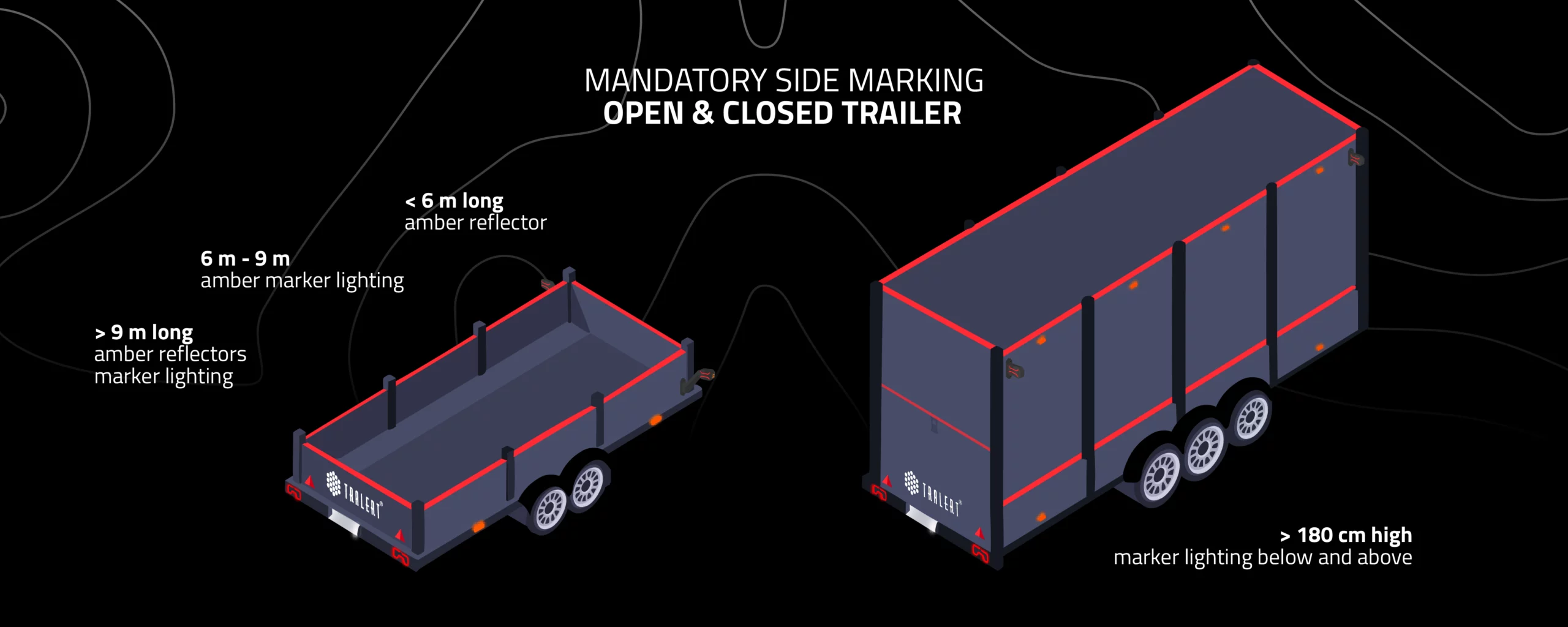
Frequently asked questions from practice
Are side lights on a trailer mandatory?
Yes, it is mandatory to install side marker lights on a trailer if the vehicle was put into use after December 31, 1997, and is longer than 6 meters.
Yes, it is mandatory to install side marker lights on a trailer if the vehicle was put into use after December 31, 1997, and is longer than 6 meters.
Where should the side-marker lamps be fitted on the vehicle?
According to the rules for trailer lighting, side marker lights must be installed on each side of the trailer. The installation should take place in the middle third section of the vehicle. Furthermore, the distance between the side lights and retroreflectors must not exceed 4 meters. Additionally, the distance from the most forward side marker light and retroreflector to the extreme front of the vehicle must not exceed 4.00 meters.
Lastly, it is important that the distance between the rearmost side marker light and the rearmost retroreflector to the extreme rear of the vehicle does not exceed 1 meter.
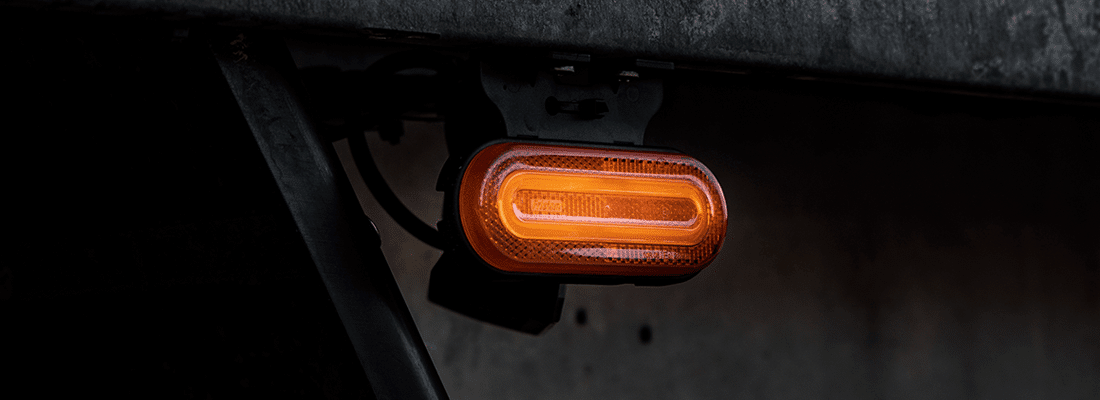
An exception to this is that if the vehicle length is not more than 6 m, also known as a bare chassis, then, when the vehicle is divided in three equal parts, one side-marker lamp is located on the front third and one side-marker lamp on the rear third of the vehicle length. In this situation one side-marker lamp is sufficient.
Furthermore, the side-marker lamps and the amber retro-reflectors must be fitted at a height of not less than 0.25m and not more than 1.5m above the road surface. If it is not possible due to the construction of the vehicle, the side-marker lamps may be installed at a height of more than 1.5 m. However, they may not be installed higher than this. However, they may not be placed higher than 2.10 m above the road surface.
Is contour lighting mandatory on a trailer?
Having contour lights on a trailer is compulsory under certain circumstances. Before we delve deeper into what contour lighting is and what rules apply, it is good to answer another question first. What is contour lighting? Contour lighting is a synonym for LED marking lights. This category of LED lights on a trailer can be found on the front, side and rear of the trailer. When we talk about the legal requirements for contour lighting on a trailer, the following rules apply.
Contour illumination on front and rear of trailer
For trailers wider than 2.10 metres, two marker lights must be fitted at both the front and rear of the trailer. As normally, the colour of the front of the trailer must be white and the colour of the LED marking lights at the rear must be red.
Contour illumination on front and rear of trailer
Orange/amber-coloured LED markings must be placed on the side of the trailer if the trailer is longer than six (6) metres.
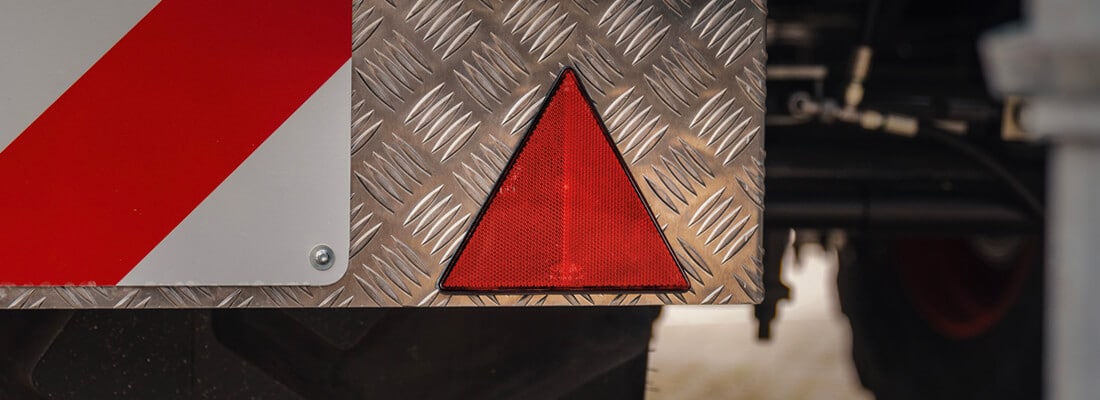
Which reflectors are mandatory on a trailer?
Reflectors are designed to enhance the visibility of the trailer alongside lighting. They also help other road users better estimate the width and length of the trailer. This is especially useful in situations where these dimensions may not be clearly visible, such as on a dark road. Specific requirements for reflectors apply to all trailers.
Mandatory reflectors on a trailer:
- Two (2) white reflectors on the front (not triangular). These reflectors must be mounted at least 250 mm and not more than 900 mm from the ground;
- One (1) orange/yellow reflector on both sides of the trailer (not triangular). These reflectors must be mounted at least 250 mm and not more than 900 mm from the ground. An additional rule for lighting on trailers is that the reflectors must not be more than one metre from the rear. There must also be no more than three metres between the reflectors on the side.
- Two (2) red reflectors at the rear. The red reflectors must be mounted at least 350 mm high from the ground and may not be higher than 1500 mm. There must be at least 600 mm between the reflectors. For trailers that are narrower than 1300 mm, there must be at least 400 mm between the two reflectors.
If you want to make your trailer even more visible, it is also possible to mount extra reflectors on the trailer. This is not compulsory according to the rules for lighting on a trailer, but it is certainly possible. However, it is strongly recommended to use the correct distances. In general, this is not very strictly controlled, but it is good to stick to the rules. Besides reflectors, you also have reflective tape. This looks good on a trailer and can also ensure even better visibility.
Types of reflectors on a trailer
Reflectors come in various sizes and shapes. The shape of reflectors is important as it serves different functions. Additionally, it is crucial to install the correct reflector in the appropriate location. Reflectors are primarily available in three shapes: round, rectangular, and triangular. Round and rectangular reflectors are available in different colors. For example, round reflectors are available in red, amber/yellow, and white, while rectangular reflectors come in amber/yellow and white. The mandatory triangular reflector is only produced in red. In some LED lamps in our assortment, the reflector is already integrated.
Is width lighting mandatory on a trailer?
LED side marker lights on trailers up to a maximum width of 1.6m are not mandatory according to the trailer lighting regulations. However, it is important to indicate the width of trailers in this category differently. This is done through the reflectors described above. When a trailer is wider than 1.6m, side marker lights are mandatory.
Exceptions for certain countries
Although the general guidelines are followed in most European countries, specific additional requirements or interpretations may vary by country. It is therefore advisable to always consult local laws and regulations or contact the relevant authorities to ensure that your vehicle complies with all national legal requirements.
Netherlands
- Responsible authority: Netherlands Vehicle Authority (RDW)
- Relevant regulation: Vehicle Regulations, Article 5.12.51
- Website: www.rdw.nl
Germany
- Responsible authority: Federal Motor Transport Authority (KBA)
- Relevant regulations: Road Traffic Licensing Regulations (StVZO)
- Information on approval: www.kba.de
Italy
- Responsible authority: Ministry of Infrastructure and Transport
- Relevant regulation: Highway Code, Article 151
- Website: www.mit.gov.it
France
- Responsible authority: Ministry of the Interior
- Relevant regulation: Highway Code, Article R313-1
- Website: www.interieur.gouv.fr
United Kingdom
- Responsible authority: Driver and Vehicle Standards Agency (DVSA)
- Relevant regulation: Road Vehicles Lighting Regulations 1989, Regulation 18
- Website: www.gov.uk/dvsa
Background information on the legislation
The United Nations Economic Commission for Europe (UNECE) establishes the basic standards applicable to vehicles, including trailers. This is done through the so-called ECE regulations.
This regulation details the mandatory lighting requirements for trailers, such as the placement, color, and functionality of lights and reflectors.
Each country bases its national regulations on these UNECE standards. However, national authorities may establish additional requirements or exceptions specific to that country.
Examples of such organizations include the RDW in the Netherlands, the TÜV in Germany, and the DVSA in the United Kingdom. These organizations ensure that vehicles (including trailers) meet the standards and grant approval for use on public roads.
The choice of TRALERT®
If you are looking for lighting for your trailer, we recommend this complete set from TRALERT®. The set includes taillights, clearance lights, license plate lights, and wide lights, allowing you to not only drive safely but also stylishly with our thoughtful selection.
Better Light Work Safer!
Connecting trailer lights?
In the above blog, you’ve read everything about the different rules regarding lighting on a trailer. Besides having proper lighting, it’s also essential to connect it correctly. There are various types of cables and connections involved. Want to learn more about connecting trailer lighting and the associated wiring diagrams? Then check out our other article on trailer lighting.
Disclaimer:
At TRALERT®, we make every effort to keep the information in this article as accurate and up-to-date as possible, including regulations regarding vehicle lighting. However, legislation can change frequently, and while we strive to implement these updates promptly, certain updates or adjustments may not yet be reflected in this article. Therefore, we advise our readers always to check the current legislation with their local government agencies or regulatory bodies, especially concerning exceptions or specific national regulations. TRALERT
Always contact the competent authority in case of doubt to ensure that your vehicle complies with all legal requirements.

